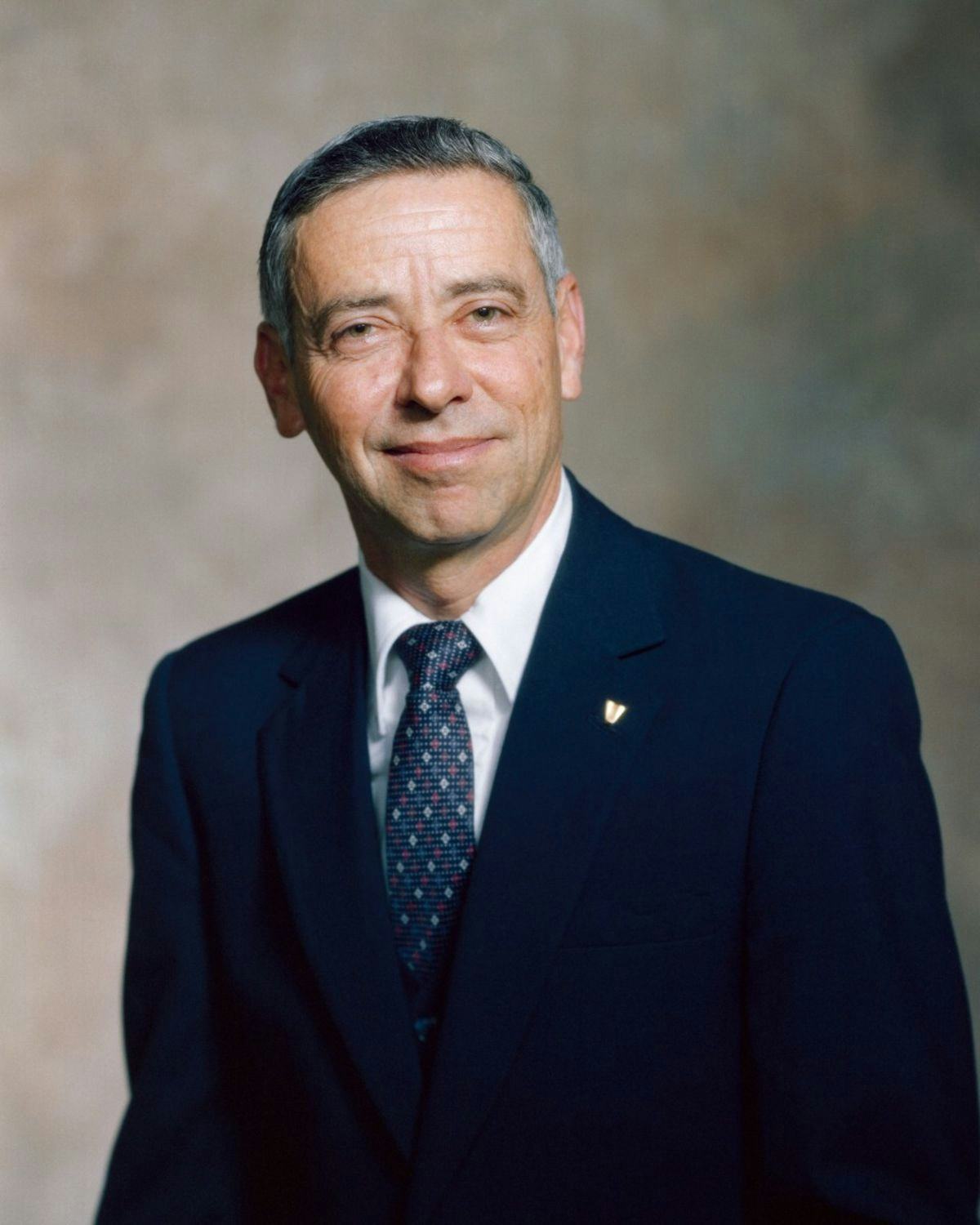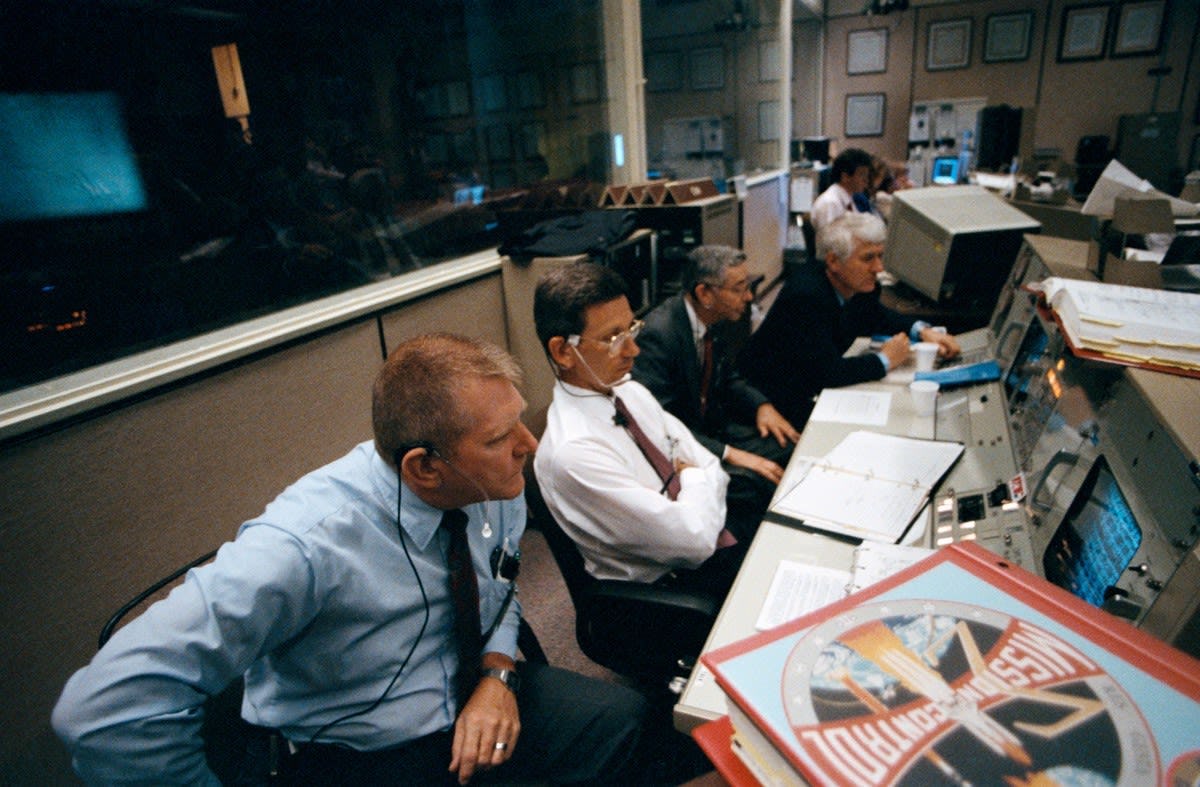Stevens graduate Aaron Cohen M.S. '58 Hon. D.Eng. '82 helped America land on the moon and sustain a Space Shuttle program
Ambitious plans by NASA to restart America's successful lunar-landing program — and by NASA and SpaceX to launch manned rockets to Mars within the next decade — are big news, and justifiably so. A new age of space exploration may soon be dawning.
It won't be the first foray into space, of course. There once was a time when strangers crowded excitedly around televisions to watch Americans walking the gray surface of the moon, when they gazed up at the night sky together in sheer wonder at the audacity of that odds-defying accomplishment. Ten years later, space shuttles began routinely blasting off from Florida every few months, like clockwork, orbiting the planet like majestic, oversized jets for a week or two — so routinely they became taken for granted — a program that continued on for three full decades.
Whether you remember those earlier eras or not, you may be surprised to learn that remarkable Stevens graduate Aaron Cohen M.S. '58 Hon. D.Eng. '82 was at the center of it all.
Cohen became a pioneering technical manager in America's then-new space program in the late 1960s and early 1970s, the project director who supervised the design and development of many of the new technologies required to send humans into space for the first time. He played a critical role in the success of all six lunar landings. Later, he directed the massive Lyndon B. Johnson Space Center (JSC) in Houston — mission control for all manned flight missions, and still home to Stevens graduates today. And Cohen was also responsible for engineering and successfully managing the space shuttle orbiter during its uncertain early years.
"Aaron Cohen was one of my early mentors here in NASA," recalled NASA Administrator Charles Bolden in remembrance when Cohen passed away in 2010, "and he was instrumental in the success of numerous pivotal achievements in human space flight."
From TV engineer to lunar-project leader
Born to Russian immigrant parents in northeast Texas and raised in San Antonio, Cohen received a bachelor's in mechanical engineering from Texas A&M University in 1952, then served several years in the armed forces, including time in Korea — rising to first lieutenant — prior to beginning a professional career.
During stints as a research engineer at RCA working on early color television sets and microwave ovens, and at General Dynamics (which bid for huge government contracts to supply launch vehicles to NASA's moon mission), Cohen completed a master's in applied mathematics at Stevens. He also published detailed new rocket-science research on such topics as "Cryogenic Pumping of Non-Condensible Gases" and "Refractory Metal Facings and Protection of Metal Surfaces Subjected to Repeated High Temperature Pulses" in professional engineering journals.
In 1962, inspired by America's feverish space race with the Soviet Union, Cohen made the leap to NASA in Houston to join the lunar-landing program President John F. Kennedy had recently announced. For one of his first projects, the young systems engineer was tasked with figuring out the electrical, mechanical and other functional interfaces and specifications to connect more than 1,200 physical and technical systems in the command, service and lunar modules and booster and rocket equipment to each other.
"You can't define an interface until you have something designed, and you can't design something until you have the interface designed," he recalled of the task later, during a 1998 interview for an oral history of JSC. "So it's very, very difficult to define interfaces…That's one of the toughest jobs to do."
Working marathon sessions in the theater-like firing room at Kennedy Space Center in Florida, Cohen and his team sorted out the thousand-plus interfaces and their solutions in just one week. It would take another six months for NASA teams to engineer the fixes, but he had made his mark.
"I felt that was one of [my] biggest accomplishments…as a junior engineer, to really resolve all those interfaces," he told JSC's historian.
NASA took notice of Cohen's organizational skill and intellect, assigning him increasing responsibility as the Apollo program moved forward, including helping the agency dissect and learn from the horrific 1967 fire that killed three astronauts during a launch-rehearsal test for the first crewed Apollo flight. Cohen’s team spent four months in a Los Angeles-area aviation plant, meticulously breaking down the accident and redesigning the space capsule's main hatch (to open inward, and more quickly), adjusting the mix of gases in the cockpit, and making other changes to ensure a flash fire would not happen again.
Soon afterward, Cohen was suddenly tapped to evaluate an exciting new project: the development, construction, testing and completion of Apollo lunar command and service modules (CSMs), two vehicles that would be essential to landing humans on the moon's surface and returning them safely to Earth.
The cone-shaped command center and its cylindrical attached service module would need to travel five days and more than 240,000 miles to the moon, rationing power and using gravity to assist; orbit for several days in a holding pattern, while astronauts landed on the lunar surface and worked; then point home, navigating and flying another 240,000 miles back. They would also need to separate cleanly before re-entering Earth's atmosphere, and — in the command module's case — splash down gently.
Cohen was charged with recommending whether the modules were suitable for the moon-landing effort or not. If they were, he would then be shouldered with an awesome responsibility: as chief of the module program, he would be engineering craft to keep American astronauts alive in space and during re-entry. The viability of the mission depended, in part, upon his technical judgment and management skills.
If there was pressure, Cohen didn't show it, and the first-ever lunar orbit — performed by the three-man crew of Apollo 8 on Christmas Eve, 1968 — proved he could successfully manage an unprecedented, almost unthinkable, engineering challenge.
"I still have a copy of the [key recommendation] memo," recalled Cohen later. "After the flight, I got [Apollo 8 astronaut] Frank Borman to sign it. It's one of my prized possessions. It's a copy of that memo, and Frank says, 'Aaron, you're right, it was a great vehicle.'"
After two moon landings in 1969, during which the modules performed flawlessly and played an integral part in making scientific history, the CSMs were handed to Cohen to manage for America's final five lunar-landing missions. From 1970 through the program's conclusion in 1972, four of five launch attempts would successfully land on the moon's surface, continuing to expand our knowledge of space in ways never before thought possible.
Launching a shuttle, leading a space center
In 1972, Cohen was tapped to create and direct NASA's new Space Shuttle Orbiter Program. He directed the program for a decade, building the shuttle and progressively testing both manned and unmanned versions, culminating in the successful 1981 launch of Earth's first reusable manned orbital spacecraft.
"Much, much more complicated than the Apollo [spacecraft]," Cohen remembered in 1998. "It's a launch vehicle, it's a spacecraft, and, of course, it's an airplane, so it's three functions. It really was a challenge."
Budgets had tightened since the original space race with the Soviets. Yet, once again, Cohen turned an unimaginably complex design concept into reality.
"He was responsible for the design, development, tests, and the budget of the shuttle from the time it started to the time it flew," noted Christopher Kraft, the legendary NASA flight director during the Apollo and early space shuttle eras.
"He also always had a good relationship with the crews; they respected him a lot," adds Mike Coats, who logged more than 450 hours aboard the shuttle before later being selected as director of JSC. "Not all senior managers at NASA would necessarily listen to the astronaut, but he did."
Cohen would go on to preside over the first four successful orbital shuttle missions — carried out in rapid-fire succession, within less than one year — receiving an honorary doctor of engineering degree from Stevens in 1982. Proud of his association with the university, he told the assembled new graduates on Castle Point that spring day "the opportunities that lie ahead are exciting and challenging," but that they were "well-equipped to meet the challenge."
The shuttle program would go on to run 30 more years; they were not all easy years, however.
When the 1986 Challenger explosion tragically took the lives of seven astronauts, threatening the shuttle's continued existence and pausing the program for nearly three years, Cohen "provided the critical and calm guidance needed at the Johnson Space Center to successfully recover and return the space shuttle to flight," recalled Bolden.
On the heels of that experience managing the Challenger's aftermath, Cohen was next tapped to direct JSC in 1986, a tremendous honor. He would remain at Johnson for seven years, supervising thousands of personnel and multiple technical projects and plans, until his retirement in 1993. Then Cohen returned to Texas A&M to teach, enjoy time with his three children and their children, and continue advising NASA.
He even anticipated travel to the Red Planet.
"I'm convinced that students of mine will, if they desire to become astronauts, be able to walk on Mars," he told an interviewer in 1999.
When Coats was chosen as the tenth director of JSC in 2005, one of the first things he did was contact his predecessor. By now approaching his mid-70s, the former director leaped at the opportunity, speaking with Coats frequently and even traveling down to Houston on occasion to visit the Space Center.
"He became a good mentor," recalled Coats. "He was not an arrogant guy — he was confident but very open-minded, and I really appreciated the advice he gave. It helped me to be a better director. We found out that NASA could learn from other people doing similar things if we just talked to them, which had been Aaron's advice to me."
Throughout his career, Cohen's philosophy of engineering remained relatively straightforward.
"Get out and touch the real hardware," he would often say, speaking about the complex projects he shepherded. "When things go wrong, look for innovations, the unusual solutions."
His philosophy of life was equally direct: "Have great respect," he would say, "for your fellow human beings."
The admiration was mutual.
"I had tremendous respect for Aaron," concludes Coats. "He was a quiet, competent leader; he tended to listen really well; and I learned a lot from him.
"He truly was one of my role models."
Aaron Cohen's reminiscences are archived online by NASA at www.jsc.nasa.gov/history/oral_histories/CohenA/cohena.htm.





